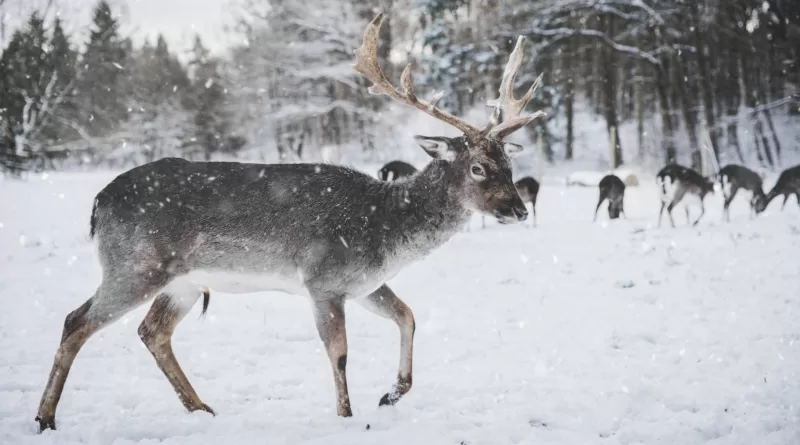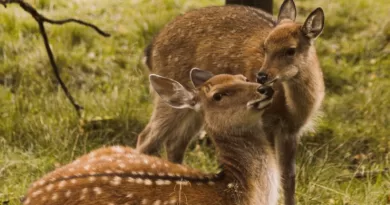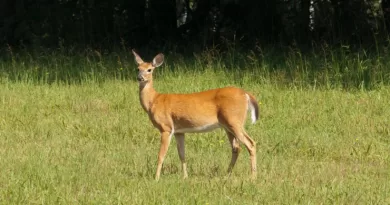How Do Deer Survive in Winter
Winter Adaptations: Exploring the strategies deer use to survive the harsh winter conditions
Deer have developed a range of strategies to help them survive the harsh conditions of winter. One of their most noticeable adaptations is the thickening of their winter coats. During this time, their fur undergoes a change, becoming thicker and denser to provide insulation against the cold temperatures. This insulating layer helps to trap body heat and keep the deer warm, allowing them to conserve energy.
In addition to their thick coats, deer also rely on various food sources to sustain themselves throughout the winter. Their diet may consist of woody browse, such as twigs and buds, as well as bark from trees. Deer are highly selective in their feeding habits during this time, searching for the most nutritious and energy-rich food available. They are also known to forage on grasses, herbs, and even fallen acorns when other food sources are scarce. This ability to adapt their feeding habits allows them to meet their nutritional needs and survive the winter months.
Thick Winter Coats: Understanding how deer’s fur changes and provides insulation during winter months
Deer, like many other mammals, have a remarkable ability to adapt to their environment, and one of the ways they do this is through their thick winter coats. As the winter months approach, the fur of deer undergoes a significant transformation to ensure their survival in the harsh conditions. The fur becomes denser and longer, creating an additional layer of insulation that helps to retain body heat and keep the deer warm.
The adaptation of the fur goes beyond just its thickness. The fur’s structure also plays a vital role in providing insulation. Each hair of the deer’s winter coat is hollow, trapping air within and preventing heat loss. This air acts as a natural insulator, creating a barrier between the cold outside environment and the deer’s body. Additionally, the winter coat features an oily outer layer that helps repel moisture, keeping the deer dry and further protecting it from the bitter cold. Overall, the thick winter coat of the deer is a remarkable adaptation that allows these creatures to survive and thrive in the coldest of winters.
Food Sources: Examining the different types of food deer rely on to sustain themselves in winter
During winter, deer face the challenge of finding adequate food sources to sustain themselves. They rely primarily on browsing, which involves feeding on the leaves, twigs, and buds of woody plants. Some of the common types of browse include American beech, red maple, and white cedar. Deer are able to digest the cellulose found in the fibrous plant material due to the presence of specialized microorganisms in their rumen. These microorganisms break down the cellulose, allowing deer to obtain the nutrients they need for energy.
In addition to browsing, deer also rely on herbaceous plants for sustenance during the winter months. They feed on grasses, sedges, and various types of forbs such as goldenrod and aster. These plants provide an important source of carbohydrates and protein for deer. Despite the scarcity of fresh green vegetation in winter, deer are able to find patches of herbaceous plants, especially in areas with thin snow cover or south-facing slopes where the snow melts faster. By diversifying their diet and adapting to the available food sources, deer are able to survive the harsh winter conditions.
Foraging Techniques: Discovering how deer adapt their feeding habits to find food beneath the snow
During the winter months, when the ground is covered in a thick blanket of snow, finding food becomes a challenging task for deer. However, these resilient animals have developed remarkable foraging techniques to adapt to these harsh conditions. One of the strategies that deer employ is referred to as “browsing,” which involves nibbling on twigs, small branches, and buds found on trees and shrubs. By utilizing their long necks and agile bodies, deer are able to reach high into the branches, even in deep snow, to feed on these available food sources.
Additionally, deer also make use of their sharp hooves to dig through the snow in search of hidden treasures. They will scrape away the top layer of snow to uncover nutritious grasses and other plants that may still be accessible. Deer are also known to create pathways in the snow, often referred to as “deer trails,” which they use repeatedly to navigate the snowy landscape and reach their preferred food sources. These trails not only save energy for the deer, but they also make it easier for other members of the herd to follow suit and find food. Overall, the foraging techniques of deer during winter serve as a testament to their resourcefulness and determination to survive in even the harshest of conditions.
Migration Patterns: Investigating the role of migration in deer populations during winter
During the winter months, migration plays a crucial role in the survival of deer populations. As temperatures drop and food sources become scarce, many deer embark on long journeys in search of more favorable conditions. This seasonal movement allows them to access essential resources such as food, water, and shelter that may not be available in their current habitat. Migration also helps to reduce competition between individuals within a population, as deer disperse to different areas, thereby decreasing pressure on limited resources. By relocating to regions with more abundant food and milder weather, deer can increase their chances of surviving the harsh winter conditions.
The decision to migrate is driven by a combination of factors, including genetics, environmental cues, and individual experience. Some deer populations have evolved specific migratory behaviors, following well-established routes year after year. These migratory patterns are often passed down from one generation to the next, allowing deer to benefit from the accumulated knowledge and experience of their ancestors. Additionally, environmental cues such as decreasing daylight and changing temperatures act as triggers, signaling to deer that it is time to embark on their migratory journey. However, not all deer populations migrate. In areas where food remains relatively abundant during winter or where the climate is less severe, deer may choose to stay in their current habitat, employing alternative survival strategies.
Energy Conservation: Explaining how deer conserve energy by minimizing movement and staying in sheltered areas
During the winter months, deer have developed remarkable strategies to conserve energy and increase their chances of survival. One of the primary ways they achieve this is by minimizing their movement. Instead of constantly expending energy by roaming around, deer will often stay in a relatively small area, conserving their precious energy reserves. By limiting their range, they decrease the amount of energy needed to search for food and avoid potentially dangerous situations. Additionally, staying in sheltered areas helps deer conserve energy by providing them with protection from harsh weather conditions. Dense vegetation and treeline cover offer a shield against strong winds, reducing heat loss and ensuring deer can conserve their energy for essential bodily functions, such as maintaining body temperature and metabolizing stored fat.
In their efforts to conserve energy, deer also exhibit behavioral adaptations that play a vital role in their survival. As temperatures drop, deer become less active during daylight hours when the energy demands are highest. Instead, they tend to conserve energy by being more active during twilight periods or even nighttime. During these hours, weather conditions are generally cooler, and there is less direct competition for available resources. This strategic timing allows deer to exploit scarce food sources while minimizing energy expenditures, ultimately increasing their chances of survival during the winter season.
Social Behavior: Discussing how deer gather in groups to increase their chances of survival in winter
Deer are known for their social behavior and tendency to gather in groups, especially during the harsh winter months. This behavior plays a crucial role in increasing their chances of survival. By forming herds, deer are able to utilize their collective senses to detect potential threats and predators more effectively. Additionally, being in a group allows them to conserve body heat by huddling together, providing warmth and insulation against the cold winter temperatures.
Not only does gathering in groups provide physical benefits, but it also aids in finding food sources. Deer have a hierarchical structure within their herds, with dominant individuals leading the way in search of forage. This ensures that the entire group can benefit from the combined efforts of multiple individuals in locating and accessing food. By working together, the deer are able to optimize their foraging activities, increasing their overall chances of finding enough sustenance to survive the winter months.
Winter Water Sources: Exploring the challenges deer face in finding water during frozen months
Finding water during the frozen winter months is a major challenge for deer. As lakes, rivers, and streams freeze over, the natural water sources that deer rely on become inaccessible. In their search for water, deer often have to resort to licking snow or consuming plant material with higher water content. However, these alternative water sources may not provide enough hydration for deer to thrive, leading to dehydration and potential health issues. Without access to sufficient water, deer’s overall well-being and ability to survive the winter can be significantly compromised.
In addition to the scarcity of available water, the freezing temperatures pose another obstacle for deer. When water sources freeze, deer are often forced to break through the ice to access the water beneath. This requires significant effort and energy expenditure, which can be detrimental, especially when combined with the challenges of finding food in the winter. Moreover, the risk of injury increases as deer navigate icy surfaces and attempt to break through frozen water sources. The search for water becomes not only a survival necessity but also a delicate balancing act between obtaining hydration and avoiding potential dangers.
Predation Risks: Highlighting the increased vulnerability of deer to predators during winter
During the winter months, deer face heightened predation risks due to a combination of factors. One of the main reasons for their increased vulnerability is the scarcity of food sources. As the snow covers the ground, it becomes more difficult for deer to find nutritious plants and vegetation. This forces them to venture into open areas in search of food, making them more exposed to potential predators. Additionally, the harsh winter conditions affect their agility and ability to escape from dangerous situations. The snow-covered terrain slows them down, making it easier for predators to catch up to them. As a result, deer become easy targets for predators seeking to take advantage of their weakened state.
Another factor contributing to the increased predation risks is the lack of cover during winter months. With the vegetation stripped bare and trees devoid of their leaves, deer are left with limited hiding spots to protect themselves from predators. Their natural camouflage, which typically helps them blend into their surroundings, becomes less effective in the snowy landscape. Without sufficient cover, deer are more visible and easily detectable by predators, further increasing their vulnerability. As a result, predators such as wolves, coyotes, and mountain lions are more successful in capturing deer during the winter season. This heightened predation pressure can have significant impacts on deer populations, necessitating their adaptation and survival strategies during this challenging time of year.
• Scarcity of food sources due to snow-covered ground
• Deer forced to venture into open areas in search of food
• Harsh winter conditions affect agility and ability to escape from predators
• Snow-covered terrain slows them down, making it easier for predators to catch up
• Lack of cover and limited hiding spots during winter months
• Natural camouflage becomes less effective in snowy landscape
• Deer are more visible and easily detectable by predators
• Predators such as wolves, coyotes, and mountain lions are more successful in capturing deer during winter season
Human Impact: Addressing the potential effects of human activities on deer survival during winter months
The potential effects of human activities during winter months can have a significant impact on the survival of deer. One of the major concerns is the disturbance caused by human presence in their natural habitats. As deer try to conserve energy and find adequate food sources, encountering human activity can disrupt their routine and lead to increased stress levels. This can result in deer using up vital energy reserves and becoming more vulnerable to the harsh winter conditions.
Another aspect of human impact on deer survival is the disruption of their food sources. With human development encroaching upon their habitats, deer are often forced to seek alternative food options. This can lead to them relying on winter food sources that do not provide the necessary nutrients and energy, ultimately weakening their immune systems and increasing their susceptibility to diseases. Additionally, the depletion of natural vegetation due to human activities reduces the availability of browse and forage options for deer, further compromising their ability to survive the winter months.
What are some of the strategies that deer use to survive winter conditions?
Deer use various strategies to survive winter conditions, such as growing thicker winter coats, adapting their feeding habits, conserving energy, and gathering in groups.
How does a deer’s fur change during winter months?
Deer’s fur becomes thicker and provides insulation during winter months to help them stay warm in cold weather.
What types of food do deer rely on to sustain themselves in winter?
Deer rely on various types of food, including twigs, bark, and evergreen needles, as well as any remaining grass or plant material.
How do deer adapt their feeding habits to find food beneath the snow?
Deer use foraging techniques to find food beneath the snow, such as scraping away the snow with their hooves or using their sense of smell to locate buried vegetation.
Do deer migrate during winter months?
Yes, some deer populations exhibit migration patterns during winter, moving to areas with more favorable food and shelter conditions.
How do deer conserve energy during winter?
Deer conserve energy by minimizing their movement and staying in sheltered areas, reducing the need for excessive exertion and preserving their energy reserves.
Why do deer gather in groups during winter?
Deer gather in groups during winter to increase their chances of survival. By staying together, they can better detect predators and share body heat.
What challenges do deer face in finding water during winter?
Deer face challenges in finding water during frozen months, as natural water sources may be inaccessible. They may rely on melting snow or seek out areas with open water sources.
Are deer more vulnerable to predators during winter?
Yes, deer are more vulnerable to predators during winter. The lack of foliage and snow cover can make it easier for predators to spot and capture them.
How do human activities potentially affect deer survival during winter?
Human activities can have various impacts on deer survival during winter, such as habitat destruction, disturbance from recreational activities, and hunting pressure, which can disrupt their feeding patterns and increase stress levels.




